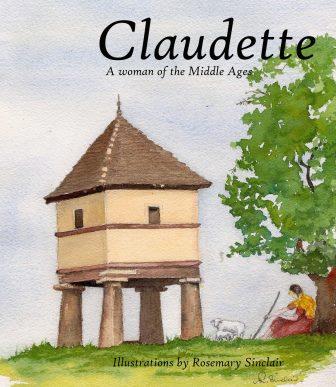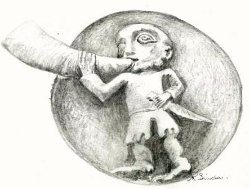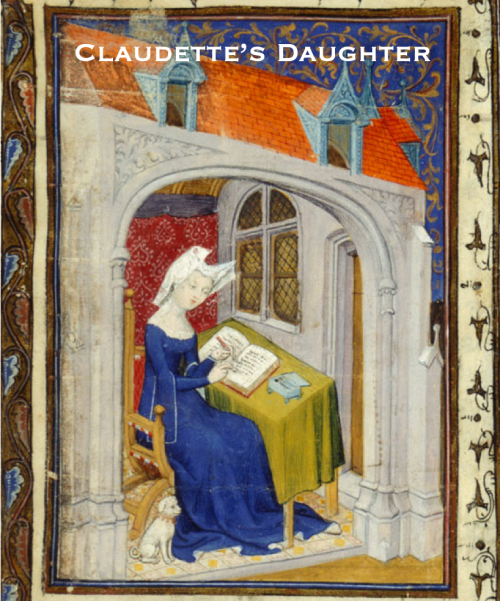In a small village, in Southern Burgundy, not far from the medieval town of Cluny where the towers of the great Abbey reached to the sky, lived the heroine of this story. In the Middle Ages, life was a struggle for women. Labelled by the church as the ‘first sinners,’ they were compared by misogynous clergy to the devil. Claudette was born into an impoverished peasant family, often hungry and despairing. Her life and that of her family changed when she went to work at the château.
C’est dans un petit village du Sud de la Bourgogne, proche de la ville médiévale de Cluny où les tours de la grande Abbaye côtoient le ciel qu’a vécu l’héroïne de cette histoire. Au Moyen-Age la vie était une lutte pour les femmes. Considérées par l’Eglise comme « les premières pécheresses », le clergé misogyne les comparait au diable. Claudette est née dans une famille de paysans pauvres, souvent affamés. Sa vie et celle de sa famille changea lorsqu’elle alla travailler au château.
About the author:
Jean Lombard was born and grew up in Dublin, Ireland. She migrated to Australia in 1968 and married John Lombard, also from Dublin. In 1989 they bought a small ruined farmhouse in a village near Cluny. Jean was inspired by life in the village to write this novel.
We passed 30 summers in the village of Chateau in France. Each year we arrived in May, to blossom in the hedgerows, rich green fields full of colourful wild flowers and a season of new life, with baby animals everywhere. Calves, lambs, foals and kids playing energetically surrounded us as we walked around our beautiful valley.
We came here by chance in 1989 when we were seeking a small holiday home in France, and stopped overnight in Cluny on our way south. We saw several homes, mostly ruins, as this was, but there was something special about this village.
Driving from Cluny the road twists and turns through verdant countryside. Suddenly we emerged at the top of a narrow road leading down into a beautiful valley. We stopped there and stared at the valley and its beauty. It was like a dream, something we had imagined, we knew this was for us, and the house although a ruin had lots of charm. We know this house was built before the French Revolution, and records were not kept before then. But there are many pieces of evidence to show that there was home here long before then, no one knows how long. This village was occupied by the Romans, and apparently there was a villa across the road from our house. Perhaps slaves lived here, or families of serfs and later free peasants, we will never know.
When I look up at the tower of the old chateau, built in the year 960, I think of Claudette and all that happened in her life there.
Click here to read Jean's thoughts on writing Claudette.
The translator:
Rachel Guyet, M.Lang, PhD
Rachel is a friend from our village in Southern Burgundy. She undertook the translation of these two books because of our friendship and understanding of what I wanted to achieve. Rachel and her husband Alain have visited Australia several times and enjoy exploring this country. They came for two months in the summer of 2015 and again in 2019, spending most of that time in Tasmania where they enjoyed travelling and where she translated Claudette and Claudette's Daughter. Together we had the opportunity to discuss the translation and the tricky differences between the original version in English and the French translation. This was a much bigger undertaking than I could have imagined, even to the differences in punctuation.
Rachel works in a French university where she is a member of a research group and runs several of their Masters programs for foreigners. She speaks several languages and travels extensively for her work.
The illustrations:
The beautifully detailed pencil drawn illustrations are by Rosemary Sinclair.
Rosemary is a talented artist, and particularly loves pencil drawing. Born on Lord Howe Island, she lost her mother at an early age and took on the care of her family. She has dedicated her life to promoting and educating on the importance of the early years of children, prevention of child abuse, and supporting new mothers. She founded the National Association for Prevention of Child Abuse and Neglect and later Good Beginnings to help and support mothers.
C’est dans un petit village du Sud de la Bourgogne, proche de la ville médiévale de Cluny où les tours de la grande Abbaye côtoient le ciel qu’a vécu l’héroïne de cette histoire. Au Moyen-Age la vie était une lutte pour les femmes. Considérées par l’Eglise comme « les premières pécheresses », le clergé misogyne les comparait au diable. Claudette est née dans une famille de paysans pauvres, souvent affamés. Sa vie et celle de sa famille changea lorsqu’elle alla travailler au château.
About the author:
Jean Lombard was born and grew up in Dublin, Ireland. She migrated to Australia in 1968 and married John Lombard, also from Dublin. In 1989 they bought a small ruined farmhouse in a village near Cluny. Jean was inspired by life in the village to write this novel.
We passed 30 summers in the village of Chateau in France. Each year we arrived in May, to blossom in the hedgerows, rich green fields full of colourful wild flowers and a season of new life, with baby animals everywhere. Calves, lambs, foals and kids playing energetically surrounded us as we walked around our beautiful valley.
We came here by chance in 1989 when we were seeking a small holiday home in France, and stopped overnight in Cluny on our way south. We saw several homes, mostly ruins, as this was, but there was something special about this village.
Driving from Cluny the road twists and turns through verdant countryside. Suddenly we emerged at the top of a narrow road leading down into a beautiful valley. We stopped there and stared at the valley and its beauty. It was like a dream, something we had imagined, we knew this was for us, and the house although a ruin had lots of charm. We know this house was built before the French Revolution, and records were not kept before then. But there are many pieces of evidence to show that there was home here long before then, no one knows how long. This village was occupied by the Romans, and apparently there was a villa across the road from our house. Perhaps slaves lived here, or families of serfs and later free peasants, we will never know.
When I look up at the tower of the old chateau, built in the year 960, I think of Claudette and all that happened in her life there.
Click here to read Jean's thoughts on writing Claudette.
The translator:
Rachel Guyet, M.Lang, PhD
Rachel is a friend from our village in Southern Burgundy. She undertook the translation of these two books because of our friendship and understanding of what I wanted to achieve. Rachel and her husband Alain have visited Australia several times and enjoy exploring this country. They came for two months in the summer of 2015 and again in 2019, spending most of that time in Tasmania where they enjoyed travelling and where she translated Claudette and Claudette's Daughter. Together we had the opportunity to discuss the translation and the tricky differences between the original version in English and the French translation. This was a much bigger undertaking than I could have imagined, even to the differences in punctuation.
Rachel works in a French university where she is a member of a research group and runs several of their Masters programs for foreigners. She speaks several languages and travels extensively for her work.
The illustrations:
The beautifully detailed pencil drawn illustrations are by Rosemary Sinclair.
Rosemary is a talented artist, and particularly loves pencil drawing. Born on Lord Howe Island, she lost her mother at an early age and took on the care of her family. She has dedicated her life to promoting and educating on the importance of the early years of children, prevention of child abuse, and supporting new mothers. She founded the National Association for Prevention of Child Abuse and Neglect and later Good Beginnings to help and support mothers.
Claudette
A Woman of the Middle Ages
by Jean Lombard
A Woman of the Middle Ages
by Jean Lombard
Claudette and the sequel Claudette's Daughter are available as an eBook and paperback in English and French from Amazon or Bookdepository.

Reader comments:
"Two things stood out to me. The authenticity of the story telling, with the historical details tightly interwoven with the plot, was superb. On top of that the sheer drama of their lives drove the story without pause to your wonderfully romantic ending. Of course I cried."
"Absolutely brilliant, hard to put it down once you start to read it, totally describes the area around Cluny!!"
"It took two breakfast specials at my favourite coffee shop, but I made it to the end of Claudette’s journey today Jean Lombard , bravo!! Can't wait for the French version to come out..."
"I loved Rosemary's delicate intricate contributions which provided a window on the architectural landscape, big and small, of the times."
"You have captured the ambience of our lovely countryside and brought to life the dry history of the Middle Ages presented to us at school. Women were brave and had to be then!"
"I so enjoyed reading your book. The colorful descriptive language transported me back in time and I felt like I was there in the middle of the drama. "
"For me, it was the depiction of the main character which I appreciated most. Claudette remains strong and in control, within the parameters of the historical time she lived in. However, I wouldn't rule out the possibility of the "Irish luck" shining upon her from the start."
"Two things stood out to me. The authenticity of the story telling, with the historical details tightly interwoven with the plot, was superb. On top of that the sheer drama of their lives drove the story without pause to your wonderfully romantic ending. Of course I cried."
"Absolutely brilliant, hard to put it down once you start to read it, totally describes the area around Cluny!!"
"It took two breakfast specials at my favourite coffee shop, but I made it to the end of Claudette’s journey today Jean Lombard , bravo!! Can't wait for the French version to come out..."
"I loved Rosemary's delicate intricate contributions which provided a window on the architectural landscape, big and small, of the times."
"You have captured the ambience of our lovely countryside and brought to life the dry history of the Middle Ages presented to us at school. Women were brave and had to be then!"
"I so enjoyed reading your book. The colorful descriptive language transported me back in time and I felt like I was there in the middle of the drama. "
"For me, it was the depiction of the main character which I appreciated most. Claudette remains strong and in control, within the parameters of the historical time she lived in. However, I wouldn't rule out the possibility of the "Irish luck" shining upon her from the start."

Horn blower carved in stone - 12th Century - 9 rue Saint-Mayeul, Cluny
The sequel to Claudette - her family are grown up and there is much suffering. Claudette's daughter tells the story of Marie Claude, her love story, jealousies and happiness. It also continues the tale of their family who went to Ireland with the Lombard stone workers.
